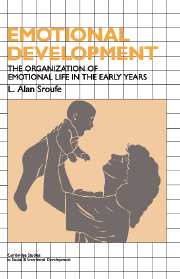Book contents
- Frontmatter
- Contents
- Preface
- Part I The nature of emotional development
- 1 A developmental perspective on emotions
- 2 Conceptual issues underlying the study of emotion
- 3 Emotion and the organization of development
- Part II The unfolding of the emotions
- Part III Emotional development and individual adaptation
- References
- Index
1 - A developmental perspective on emotions
Published online by Cambridge University Press: 16 September 2009
- Frontmatter
- Contents
- Preface
- Part I The nature of emotional development
- 1 A developmental perspective on emotions
- 2 Conceptual issues underlying the study of emotion
- 3 Emotion and the organization of development
- Part II The unfolding of the emotions
- Part III Emotional development and individual adaptation
- References
- Index
Summary
The premier developmental question is, of course, the nature of the transition from one developmental stage to another – the emergence of new forms. How does a system retain continuity and yet produce discontinuous manifestations?
Thelen (1989)The subject of this book is human emotion, with a focus on the early years. The topics include the expression of specific emotions (such as joy, fear, and anger), as well as more complex emotional reactions. Also discussed is the place of emotion in the organization and stream of behavior, ties between emotion and other aspects of functioning such as cognition, and the management or regulation of emotion by individuals. While in the past each of these topics has been approached in a variety of ways, they have often been treated individually. Here they are approached in concert and from a particular perspective, that of development.
A developmental approach offers considerable leverage for understanding behavior. It yields a dynamic view, analogous to seeing films of an animal in motion as opposed to still photographs of the animal at rest. Knowing what led up to something, the network of changes in which it is nested, and its later manifestations provides a critical perspective for understanding.
- Type
- Chapter
- Information
- Emotional DevelopmentThe Organization of Emotional Life in the Early Years, pp. 3 - 10Publisher: Cambridge University PressPrint publication year: 1996



